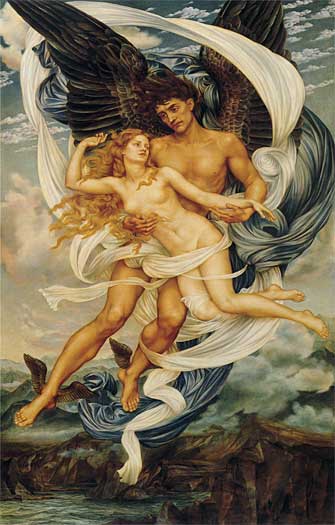Evelyn de Morgan
Mary Evelyn De Morgan, née Pickering, was a late-Victorian artist who lived and worked in a period marked by cataclysmic changes. Born mid-century in an England ruled over by Queen Victoria, she lived to see a series of changes climaxing in 1914 with the collapse of established world order. It was amidst this atmosphere of increasing uncertainty and anxiety that De Morgan came to maturity and developed her personal and artistic philosophies. Throughout her career as a painter, she used literary allusion and allegory to express her strongly held views on contemporary spiritual, social and moral issues.
Despite initial parental disapproval of her chosen career, Evelyn was a privileged woman. She enjoyed an upper-class lifestyle in London; excellent home education; instruction at the South Kensington National Art Training School (1872) and at the Slade School of Art (1873-76) under Edward J. Poynter. She had the artistic as well as moral support of her uncle, the Pre-Raphaelite painter John Roddam Spencer Stanhope (1829-1908). These advantages, when combined with Evelyn’s prodigious talent and early decision to devote her life to art, moulded a temperament that was confident and not easily deterred by obstacles such as familial apathy, the condescension of male artists and critics, and lack of robust patronage.
After leaving the Slade to pursue an independent course of study in Italy, she returned to London to begin her career as an active painter and exhibitor. Evelyn first exhibited her work at the Dudley Gallery in 1876 with her painting St. Catherine of Alexandria (1873/5). Following this, she was one of the few female artists invited to be an exhibitor at the new Grosvenor Gallery in 1877 where her painting Ariadne in Naxos (1877) was displayed in the company of works by Spencer Stanhope, Edward Burne-Jones and George Frederick Watts.
In the early 1880s, Evelyn moved her studio from her family home in Bryanston Square to the popular Trafalgar Studios in Manresa Road, Chelsea. During this period, she lived as a professional artist in London with periodic trips to Italy where she would absorb the influences of the early Italian masters. While it is likely that she spent much of this period of her life perfecting her craft, she also took an active part in the artistic/social scene of the day. With friends such as Violet Paget, Emily Susan Ford, Margaret Burne-Jones and Mary De Morgan, she attended the theatre, Royal Academy openings and art studio open-house events.
Some time during the mid 1880s she met the ceramic designer William De Morgan (1839-1917) and his family. This introduction to the bohemian and intellectual De Morgan family was clearly a turning point in her life. Her future mother-in-law, the spiritualist and social activist Sophia Frend De Morgan (1809-1892) became her informal mentor, helping to further develop the younger woman’s interest in spiritualist practices and in social reform.
In 1887 Evelyn married William De Morgan. Despite the age difference theirs was a harmonious and mutually supportive marriage. In addition to their artistic pursuits, they shared a well-documented sense of humour and an idealistic spirit. Their mutual interests included social reform, spiritualism and music. Evelyn provided financial and moral support for her husband’s pottery business, which though successful required much capital.
From the early 1890s, in the interest of William’s health, Evelyn enthusiastically accompanied him on extended stays to Florence every winter. As fellow artists, they led an idyllic life in Italy: Evelyn created her pictures, while William worked on his ceramic designs with the Italian painters he had hired. The De Morgans spent their weekends in the hills above Florence, at the sumptuous Bellosguardo villa where Spencer Stanhope had made his permanent home.































ليست هناك تعليقات:
إرسال تعليق